Karlovy Vary
Karlovy Vary (Czech pronunciation: [ˈkarlovɪ ˈvarɪ] (![]() listen); German: Karlsbad, pronounced [ˈkaʁlsˌbaːt] (
listen); German: Karlsbad, pronounced [ˈkaʁlsˌbaːt] (![]() listen)) is a spa city in the Karlovy Vary Region of the Czech Republic. It has about 48,000 inhabitants. It lies on the confluence of the rivers Ohře and Teplá, approximately 130 km (81 mi) west of Prague. It is named after Charles IV, Holy Roman Emperor and the King of Bohemia, who founded the city in 1370. It is the site of numerous hot springs (13 main springs, about 300 smaller springs, and the warm-water Teplá River), and is the most visited spa town in the Czech Republic.[2] Until 1945, when the German-speaking inhabitants were expelled, the city was overwhelmingly German-speaking.
listen)) is a spa city in the Karlovy Vary Region of the Czech Republic. It has about 48,000 inhabitants. It lies on the confluence of the rivers Ohře and Teplá, approximately 130 km (81 mi) west of Prague. It is named after Charles IV, Holy Roman Emperor and the King of Bohemia, who founded the city in 1370. It is the site of numerous hot springs (13 main springs, about 300 smaller springs, and the warm-water Teplá River), and is the most visited spa town in the Czech Republic.[2] Until 1945, when the German-speaking inhabitants were expelled, the city was overwhelmingly German-speaking.
Karlovy Vary
Karlsbad | |
|---|---|
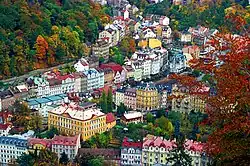 October 1997 bird's-eye view of Karlovy Vary | |
_-_flag.gif) Flag 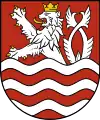 Coat of arms | |
| Etymology: "Charles' Baths" | |
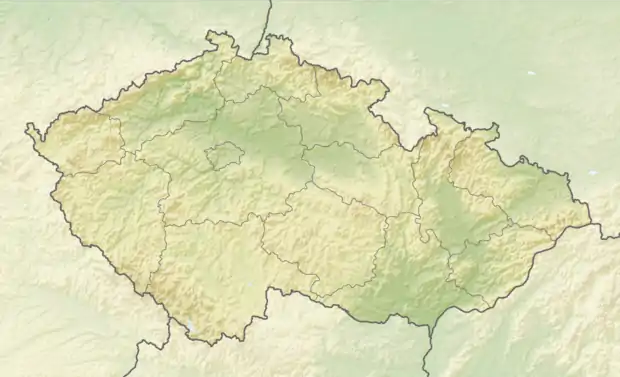 Karlovy Vary Location in the Czech Republic | |
| Coordinates: 50°13′50″N 12°52′21″E | |
| Country | |
| Region | Karlovy Vary |
| District | Karlovy Vary |
| Founded around | 1350 |
| Government | |
| • Mayor | Andrea Pfeffer Ferklová (ANO) |
| Area | |
| • Total | 59.10 km2 (22.82 sq mi) |
| Elevation | 447 m (1,467 ft) |
| Population (2020-01-01[1]) | |
| • Total | 48,479 |
| • Density | 820/km2 (2,100/sq mi) |
| Time zone | UTC+1 (CET) |
| • Summer (DST) | UTC+2 (CEST) |
| Postal code | 360 01 |
| Website | www.karlovyvary.cz |
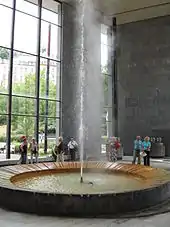
History
An ancient late Bronze Age fortified settlement was found in Drahovice. A Slavic settlement on the site of Karlovy Vary is documented by findings in Tašovice and Sedlec. People lived in close proximity to the site as far back as the 13th century and they must have been aware of the curative effects of thermal springs.[3]
From the end of the 12th century to the early 13th century, German settlers from nearby German-speaking regions came as settlers, craftsmen and miners to develop the region's economy. Eventually, Karlovy Vary/Karlsbad became a town with a German-speaking population.[4]
Around 1350, Charles IV organized an expedition into the forests surrounding modern-day Karlovy Vary during a stay in Loket. On the site of a spring, he established a spa mentioned as in dem warmen Bade bey dem Elbogen in German, (Hot Spas at the elbow) or Horké Lázně u Lokte[5] . The location was subsequently named "Karlovy Vary" after the emperor, who extolled the healing powers of the hot springs, at least according to legend. Charles IV granted the town privileges on 14 August 1370. Earlier settlements can also be found on the outskirts of today's city.
An important political event took place in the city in 1819, with the issuing of the Carlsbad Decrees following a conference there. Initiated by the Austrian Minister of State Klemens von Metternich, the decrees were intended to implement anti-liberal censorship within the German Confederation.
Due to publications produced by physicians such as David Becher and Josef von Löschner, the city developed into a famous spa resort in the 19th century and was visited by many members of European aristocracy as well as celebrities from many fields of endeavour. It became even more popular after railway lines were completed from Prague to Cheb in 1870.
The number of visitors rose from 134 families in the 1756 season to 26,000 guests annually at the end of the 19th century. By 1911, that figure had reached 71,000, but the outbreak of World War I in 1914 greatly disrupted the tourism on which the city depended.
At the end of World War I in 1918, the large German-speaking population of Bohemia was incorporated into the new state of Czechoslovakia in accordance with the Treaty of Saint-Germain-en-Laye (1919). As a result, the German-speaking majority of Karlovy Vary protested. A demonstration on 4 March 1919 passed peacefully, but later that month, six demonstrators were killed by Czech troops after a demonstration became unruly.[6]
According to the 1930 census, the city was home to 23,901 inhabitants – 20,856 were of German ethnicity, 1,446 of Czechoslovak ethnicity (Czech or Slovak), 243 of Jewish ethnicity, 19 of Hungarian ethnicity and 12 of Polish ethnicity.[7]
In 1938, the majority German-speaking areas of Czechoslovakia, known as the Sudetenland, became part of Nazi Germany according to the terms of the Munich Agreement. After World War II, in accordance with the Potsdam Agreement, the vast majority of the people of the city were forcibly expelled because of their German ethnicity. In accordance with the Beneš decrees, their property was confiscated without compensation, and the city was renamed again Karlovy Vary.
Since the end of Communist rule in Czechoslovakia in 1989 and the fall of the Soviet Union in 1991, the presence of Russian businesses in Karlovy Vary has steadily increased.
Demographics
|
| ||||||||||||||||||||||||||||||||||||
| Source: [8] | |||||||||||||||||||||||||||||||||||||
In 2012, non-Czech residents were around 7% of the population of the Karlovy Vary region. After Prague, this is the highest proportion in the Czech Republic. The largest group of foreigners were Vietnamese, followed by Germans, Russians, and Ukrainians.[9]
Transport
Local buses (Dopravní podnik Karlovy Vary) and cable cars take passengers to most areas of the city. The Imperial funicular is the oldest tunnel funicular in Europe and the steepest in the Czech Republic, the Diana funicular was at the time of commissioning the longest funicular in Austria-Hungary.[10][11]
The city is accessible via the D6 motorway and inter-city public transport options include inter-city buses, Czech Railways, and Deutsche Bahn via the Karlovy Vary–Johanngeorgenstadt railway. Karlovy Vary Airport is an international airport located 4.5 kilometres (2.8 mi) south-east from the city, at the nearby village of Olšová Vrata. In winter 2020, the airport is only serviced by scheduled flights to Moscow.
Churches

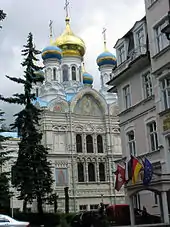

- Catholic Church of St. Mary Magdalene – built by Kilian Ignaz Dientzenhofer in 1737
- Orthodox Saint Peter and Paul Cathedral – 1898
- Protestant Church of Saints Peter and Paul – 1856
- Church of St. Anne – 1745
- Greek Catholic St. Andrew Cemetery Church – 1500
- Methodist Church of Saint Luke – 1877
- St. Linharta ruins from 13th century
- Synagogue (opened 1994)
Economy
It is also known for the popular Czech liqueur Becherovka and the production of the famous glass manufacturer Moser Glass, which is considered as the most luxurious Czech brand.[12] The famous Karlovarské oplatky (Carlsbad wafers) originated in the city in 1867. It has also lent its name to "Carlsbad plums", candied stuffed zwetschgen.
Culture
In the 19th century, Karlovy Vary became a popular tourist destination, especially known for international celebrities who visited for spa treatment. The city is also known for the Karlovy Vary International Film Festival, which is one of the oldest in the world and one of Europe's major film events.
The city has been used as the location for a number of film-shoots, including the 2006 films Last Holiday and box-office hit Casino Royale, both of which used the city's Grandhotel Pupp in different guises. Moreover, the Palace Bristol Hotel in Karlovy Vary had been used as a model for The Grand Budapest Hotel movie.
Sport
Karlovy Vary is also home to ice hockey club HC Karlovy Vary and football club FC Slavia Karlovy Vary.
Notable people
Residents
- Johann Josef Loschmidt (1821–1895), Austrian scientist
- Ignaz Ziegler (1861–1948), Austrian-Czech rabbi
- Walter Serner (1889–1942), writer, dadaist
- Karl Hermann Frank (1898–1946), Nazi official
- Károly Pulváry (1907–1999), Hungarian designer[13]
- Walter Becher (1912–2005), German-Czech politician
- Zbyněk Brynych (1927–1995), film director
- Gerda Mayer (born 1927), English poet
- Georg Riedel (born 1934), Swedish musician and composer
- Karin Stoiber (born 1943), former First Lady of Bavaria
- Rudolf Křesťan (born 1943), writer
- Princess Michael of Kent (born 1945), member of the British royal family
- Stanislav Birner (born 1956), tennis player
- Josef Řihák (born 1959), politician
- Rick Lanz (born 1961), Canadian ice hockey player
- Ludmila Peterková (born 1967), clarinetist
- Karel Dobrý (born 1969), actor
- Karel Rada (born 1971), footballer
- Jana Sýkorová (born 1973) opera singer
- Tomáš Vokoun (born 1976), ice hockey player
- Petr Kopfstein (born 1978), aerobatic pilot
- Tomáš Došek (born 1978), footballer
- Milan Šperl (born 1980), cross country skier
- Hana Soukupová (born 1985), supermodel
- Tomáš Borek (born 1986), footballer
People associated with the city
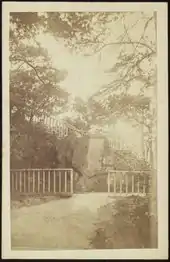
- Peter I of Russia visited Karlovy Vary in 1711[14]
- Mustafa Kemal Atatürk, founder of the Republic of Turkey, as well as its first President, visited Karlsbad in 1918 for spa treatments[15]
- František Běhounek, scientist and novelist, died here
- Johann Wolfgang Goethe,[16] German poet, novelist, philosopher, scientist
- Princess Michael of Kent (born Baroness Marie Christine Agnes Hedwig Ida von Reibnitz), a member of the British Royal Family, was born in January 1945, prior to the expulsion of the German population later that year.
- Adalbert Stifter, Austrian writer
- Ludwig van Beethoven, composer, came for spa treatments. He and the poet Goethe would take walks together, much to the delight of the local people.
- Frédéric Chopin, composer, he and his parents met for the last time during a holiday in Karlsbad, August/September 1835.
- Anthony J. Drexel, senior partner of Drexel, Morgan & Co. (JPMorgan, today) and founder of Drexel University, died in Karlsbad in 1893 while spending the summer there for his health.
- Vladimir Voronin, former president or Republic of Moldova, visits Karlovy Vary every year for spa treatments.
- James Ogilvy, 7th Earl of Findlater, Scottish noble and an accomplished amateur landscape architect and philanthropist
- Ivan Turgenev, the Russian novelist, visited Karlsbad on numerous occasions for its healing waters.
- Jean de Carro, Swiss physician, published the Almanach de Carlsbad
- Baron Gustaf Mannerheim (1867–1951), Marshal of Finland, President of the Finnish Republic in 1944–46
International relations
Carlsbad, New Mexico, United States[17] (after which Carlsbad Caverns National Park is named), Carlsbad, California, USA[18] Carlsbad Springs, Ontario, Canada, and Carlsbad, Texas, USA, take their names from Karlovy Vary's English name, Carlsbad. All of these places were so named because they were the sites of mineral springs or natural sources of mineral water.
Twin towns – sister cities
Karlovy Vary is twinned with:[19]
 Baden-Baden, Germany
Baden-Baden, Germany Bernkastel-Kues, Germany
Bernkastel-Kues, Germany Carlsbad, United States
Carlsbad, United States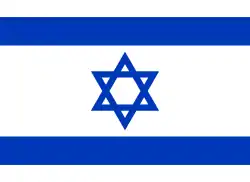 Eilat, Israel
Eilat, Israel Kusatsu, Japan
Kusatsu, Japan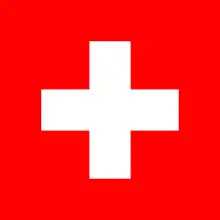 Locarno, Switzerland
Locarno, Switzerland Varberg, Sweden
Varberg, Sweden
Gallery
 Karlovy Vary
Karlovy Vary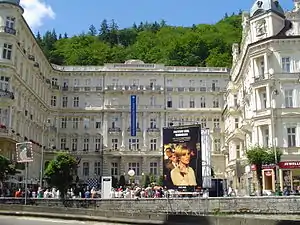 The Grandhotel Pupp
The Grandhotel Pupp.jpg.webp) Outdoor pool with mineral water in Hotel Thermal
Outdoor pool with mineral water in Hotel Thermal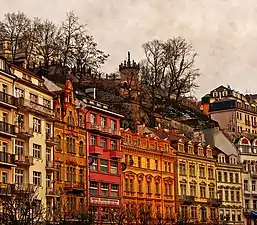 Vřídelní street, above sets of Jeanna de Carro
Vřídelní street, above sets of Jeanna de Carro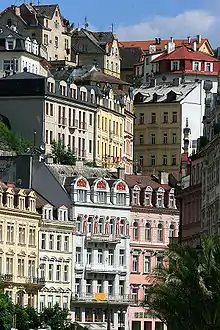 Area over Vřídelní street
Area over Vřídelní street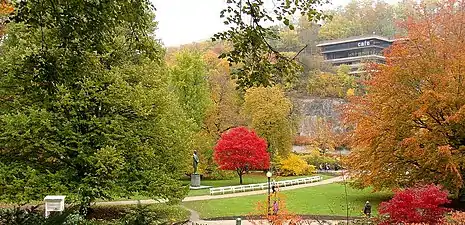 Dvořák Park
Dvořák Park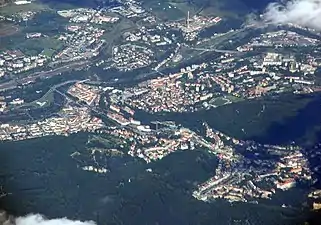 Aerial view of Karlovy Vary
Aerial view of Karlovy Vary Mineral spring
Mineral spring Karlovy Vary Airport
Karlovy Vary Airport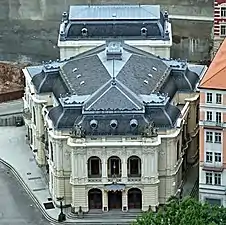 City Opera House
City Opera House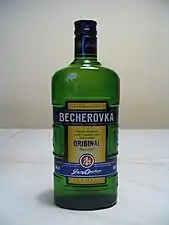 A bottle of Becherovka
A bottle of Becherovka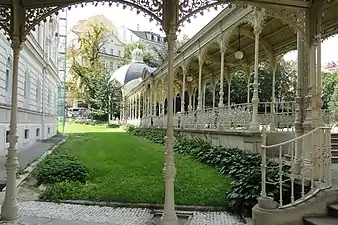 Park Colonnade
Park Colonnade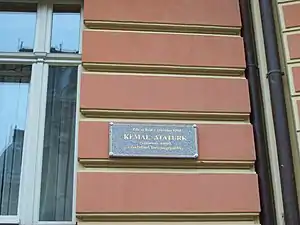 Plaque indicating the building where Mustafa Kemal Atatürk resided while in Karlovy Vary
Plaque indicating the building where Mustafa Kemal Atatürk resided while in Karlovy Vary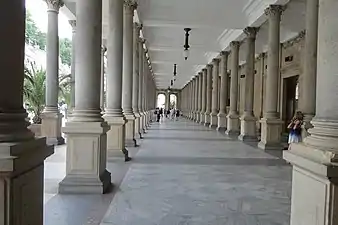 Springs of mineral water in Mill Colonnade
Springs of mineral water in Mill Colonnade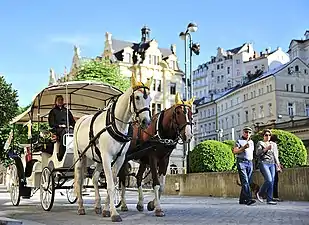 Horse drawn carriage
Horse drawn carriage.jpg.webp) Canal in Karlovy Vary
Canal in Karlovy Vary
References
- "Population of Municipalities – 1 January 2020". Czech Statistical Office. 30 April 2020.
- Vývoj návštěvnosti lázní v letech 2000–2011
- "Karlovy Vary – Urban Monument Zone".
- Walter Koschmal, Marek Nekula, Joachim Rogall (2001). Deutsche und Tschechen: Geschichte, Kultur, Politik. C.H. Beck. pp. 338–39.CS1 maint: uses authors parameter (link)
- Ivan Lutterer, Milan Majtán, Rudolf Šrámek (1982). Zeměpisná jména Československa: slovník vybraných zeměpisných jmen s výkladem jejich původu a historického vývoje.CS1 maint: multiple names: authors list (link)
- "Zdeněk Vališ: 4. březen 1919 v Kadani". Virtually.cz. Retrieved 26 March 2013.
- Fidler, Sluka (2006). Encyklopedie branné moci Republiky Československé (in Czech). Libra.CS1 maint: uses authors parameter (link)
- Historický lexikon obcí ČR 1869–2005
- Rozhlas.cz, Počet obyvatel Karlovarského kraje
- "Nejstarší tunelová lanovka v Evropě slaví 100 let". iDNES.cz. 28 May 2007.
- "Karlovy Vary – Unikátní lázně, do kterých se sjíždí celý svět". Stream.cz (in Czech).
- "Studie: Nejluxusnější českou značkou je Moser". MediaGuru.cz (in Czech).
- hu:Pulváry Károly
- http://www.hiddeneurope.co.uk/escape-from-carlsbad
- http://www.britannica.com/EBchecked/topic/40411/Kemal-Ataturk/24780/Military-career
- Johannes Baier: Goethe und die Thermalquellen von Karlovy Vary (Karlsbad, Tschechische Republik). In: Jahresberichte und Mitteilungen des Oberrheinischen Geologischen Vereins. N. F. Bd. 94, 2012, ISSN 0078-2947, S. 87–103.
- About Carlsbad, NM Archived 17 March 2012 at the Wayback Machine retrieved 2012-03-23
- City of Carlsbad - History of Carlsbad Archived 23 November 2012 at WebCite, retrieved 2012-03-23.
- "Zahraniční vztahy" (in Czech). Statutární město Karlovy Vary. Retrieved 22 June 2020.
Further reading
| Wikisource has several original texts related to: Karlovy Vary |
- "Carlsbad", Southern Germany and Austria (2nd ed.), Coblenz: Karl Baedeker, 1871, OCLC 4090237, OL 20619468M
- John Merrylees (1886). Carlsbad and its Environs. S. Low, Marston, Searle, & Rivington.
- "Carlsbad", Guide through Germany, Austria-Hungary, Switzerland, Italy, France, Belgium, Holland, the United Kingdom, Spain, Portugal, &c (9th ed.), Berlin: J.H. Herz, 1908, OCLC 36795367, OL 6607948M
- "Carlsbad", The Encyclopædia Britannica (11th ed.), New York: Encyclopædia Britannica, 1910, OCLC 14782424
- "Carlsbad", Austria-Hungary (11th ed.), Leipzig: Karl Baedeker, 1911, OL 18759934M
External links
| Wikimedia Commons has media related to Karlovy Vary. |
| Wikivoyage has a travel guide for Karlovy Vary. |
- Karlovy Vary regional television channel KTB
- Municipal website (in Czech)
- All about Karlovy Vary
- Pictures & Streetmap from 1725 (?), A. F. Zuerner/Schenck (Amsterdam)
- Pictures & Streetmap from 1733, Homannische Erben (Nuernberg)
- Visitor Information Centre Karlovy Vary
- Karlovy Vary City Card – guide, maps, discounts

